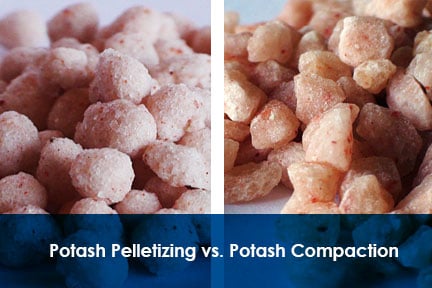There are many factors to consider when it comes to potash processing, particularly in choosing the method of granulation: pelletizing (wet granulation) or compaction. While both potash processing solutions yield successful product results, there are several dynamics that help determine the best-suited method for individual applications, with the final decision most often being driven by cost of production.
Potash Compaction
Potash compaction is accomplished using a double roll press, or compactor; potash fines are compacted between two counter-rotating rolls, and then fed into a granulator in order to fracture the material into coarse granules. Because pressure is used to compact the material, compaction granulation is a dry process that typically does not require a binder. Subsequently, potash compaction typically does not require any additional drying equipment.
While compaction granulation is a straightforward processing technique, many factors determine the overall quality of the potash granules. Roll speed, roll pressure, feed rates, and feedstock particle size distribution (PSD) must be considered in order to ensure optimal product quality.
Advantages and Disadvantages to Potash Compaction
Potash compaction is beneficial because it reduces dust problems, produces a consistent product size range, and stabilizes the material for improved handling capabilities. Even though potash compaction produces a coarse granule, the product blends easily into fertilizer formulations. Compaction also costs less from a production standpoint, since it does not require any additional expenses associated with binders or material drying equipment.
Potash compaction does have a few disadvantages. Compaction creates granules with rough edges that rub against the other potash granules, a phenomenon known as attrition, which produces fines. However, solutions are available for mitigating attrition-related issues. For example, it is not uncommon to incorporate a glazing circuit or include conditioning additives to reduce attrition.
Pelletizing Potash
Pelletizing is a wet granulation or tumble-growth agglomeration technique, which produces round, uniform pellets, unlike the more jagged granules produced in the compaction process. A disc pelletizer is typically the preferred device for carrying out this process (although a rotary drum can be used, it is requires a higher amount of recycle, which is not always desirable).
Potash is continually fed onto the rotating disc pelletizer, along with binder. The agitation, combined with the binder, causes fines to collect into masses, which upon tumbling, continue to collect fines, growing in a layering effect known as coalescence. Because moisture is added to the material, an additional drying phase is required when using this tumble growth method. A pin mixer may be employed prior to the disc pelletizer to pre-mix the binder and fines and produce seed pellets, resulting in a more uniform product and pellets that are more dense due to the spinning motion that occurs in the pin mixer.
Advantages and Disadvantages to Pelletizing Potash
There are many advantages to pelletizing potash. This non-pressure agglomeration technique creates pellets that are less dense than those created via compaction. This allows the pellets to break down more quickly in standard field conditions. Since most potash is processed for use in fertilizers, the ability to break down and provide nutrients faster is an incentive to choosing potash pellets; it is an ideal product for fertilizer compounds with fixed formulation needs that require fast nutrient delivery. The round, pelletized potash is also easy to handle and produces less potash fines than compaction granules, because very little attrition can occur with rounded granules.
The major disadvantage to pelletizing potash is its higher processing cost. Potash pellets are considered to be a premium product, and because of this, are not as commonly produced as compacted granules. Although it is important to note that in some cases, a disc pelletizing system may be the only option (as opposed to a compaction process), because of the hardness of the specific potash source at hand.
Choosing the Best Potash Processing Method
Ultimately, cost is often the major factor in determining which potash process to use. Potash compaction is a more cost-effective process, but potash pelletizing yields a higher quality product. While potash pelletizing equipment itself costs less than compaction equipment, the additional processing cost required in the pelletization method typically outweighs this initial cost benefit.
Potash producers interested in evaluating the pelletizing process can test their material in the FEECO Innovation Center, where batch- and pilot-scale equipment are used to determine feasibility, establish basic process parameters, and fine-tune the process on a continuous basis for scale-up. Data gathered during testing is then used to inform engineering decisions for equipment design and fabrication.
FEECO is a leader in the potash processing industry, providing custom potash processing equipment, process development services, and parts & service support. For more information on our potash processing solutions, contact us today!


